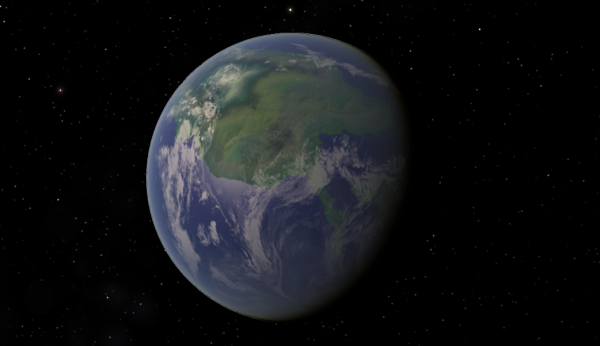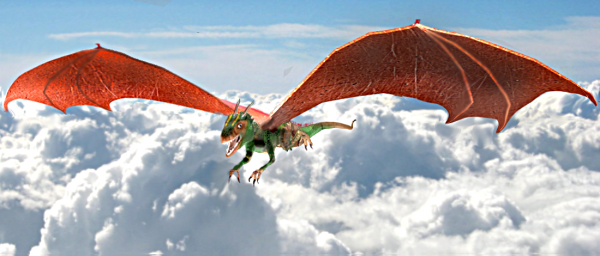BY LETTER
Kulshedra
Galactography > Other Major Polities, Empires, and Meta-Empires > Archosaurian Empire
Galactography > Regions of Space > Middle Regions/Hinter-regions
Galactography > Systems and Worlds > Systems & Worlds K - L
Galactography > Regions of Space > Middle Regions/Hinter-regions
Galactography > Systems and Worlds > Systems & Worlds K - L
World inhabited by geneered dragons | |
 Image from Steve Bowers | |
| Kulshedra is a terraformed Mars-like world with relatively low surface gravity | |
Star
Name: TYC 3982-1662-1
Type: F3v
Luminosity: 7.51 x sol
Distance from Sol: 2652 ly
Constellation: Lacerta
Colonised: 7209
Planet
Name: Kulshedra
Type AreanLacustric terraformed to NeoGaian
Diameter: 9091 km
Surface Gravity: 0.68 gees
SemimajorAxis: 2.8 AU
Orbital Period: 3.6 standard years
Day Length: 31.1 standard Hours
Obliquity: 9°
This planet was colonised in 7209 by the Maastrichtian Corpus, a minor faction of archosaur lauzurogen provolves. MC included a number of species of intelligent dinosaurs and pterosaurs which had been originally created by GEvidian in the Utopia Sphere but were living in the Archaipelago, M39 in Cygnus. Maastrichtian Corpus came into ideological conflict with the Toh Chi Lok-Nar, and most of the membership were transported on a Cygexpa exploration vessel to a relatively sparsely settled volume of Lacerta 1600 light years outwards from M39. The transapient-captain of the ship assured the dinos that they could expect a wormhole connection in a few decades, but this did not arrive - probably due to the dissolution of the Cygexpa empire.
Maastrichtian Corpus were enthusiasts for genetic self-modification; rather than remain as artificially reconstructed dinosaurs from Earth's long-vanished past, they wished to explore new body-types. On Kulshedra, with its relatively low gravity and tall atmosphere, many of the colonists elected to explore the possibilities of flight.
Several pterosaurian clades among the Kulshedra population were already good fliers, and when the planet was fully terraformed in the 76th century these groups gained access to the vast airscapes above the clouds. Many of these clades engineered themselves to become larger and more active fliers, some capable of carrying smaller dromaosaurs on their backs. But soon the theropod clades were also adapting themselves for flight in a variety of ways, from mechanical flight suits to somatic reconstruction, and eventually germ-line engineering. The end result was a wide range of body-designs that resembled the dragons of Old Earth myth.
 Image from Steve Bowers | |
| A Dragonrex flies above the high-stacked clouds of Kulshedra | |
Dragons had been engineered on many worlds in the past, usually as pre-sophont pets. In fact several of the Maastrichtian colonists had small dragon-pets already, some of which would be provolved in the early history of Kulshedra. But there were few worlds where most of the citizens were themselves flying lizards. The largest and most ferocious dragon on Kulshedra was the Dragonrex, a significantly modified tyrannosaur/pterosaur hybrid.
Geography and Political Regions
Kuldhedra has three large continents, each with high mountains in the interior. Many dragon cities are built into the steep foothills of these ranges, mostly constructed and maintained by sauropod biobots designed by the Maastrichtians themselves. These so-cauld 'handysaurs' are organic bots resembling small brachiosaurs, equipped with several pairs of useful manipulatory limbs at the front end. Dragon cities are usually built into cliffs, with balconies and ramps leading up to deep excavations into the cliff. Projecting out at intervals are long cantilevered perches upon which they land, and onto which they launch themselves. In parts of the country which have no cliffs or mountains they sometimes inhabit Akilaspek trees.The largest continent, Limburg, is the most densely populated. The traditionalists of Limberg maintain a close relationship with the Archosaurian Empire, although they are not officially members; a wormhole connecting indirectly to the Archaipelago finally arrived in 8707. The Limburg dragons are enthusiasts for genetic self-modification and are constantly tweaking their own bodyplans to conform with a constantly changing standard of aesthetics. Most of this faction follow a bioist religion, so are forbidden to take life (or rather they do not kill animals above a certain strictly defined level of sentience). Traditionally, flesh-eating clades in Limburg refuse to eat wild animals, preferring to catch prey-bots with easily retrievable subsentient cybersystems; the continent of Limburg contains large savannahs where herds of prey biobots and other non-prey animals live.
However the dragonrexes of the Jekerk Confederacy, a polity extending over most of the second largest continent and a significant part of the third (Wyck) are less restrained. They are unashamed predators, delighting in the hunt; often chasing real prey and consuming them in the field after grilling them with fire (produced by hi-tech flame projectors in their mouths). The Confederacy maintains a fierce independence from the Archosaurs, and in the current millennium they are forging ever closer bonds with the Panvirtuality, especially those inhabiting the power-swarm around the bright yellow supergiant HD212466, one hundred and twenty-three light years away. The Jekerk dragons have strict taboos against untruth, hypocrisy and insincerity; they are sincere in their ferocity, and respect ruthlessness in their fellows.
Along the coasts of these continents sophont pterosaurs live in cliff-top eryies, hunting for fish in the ocean shallows, where they often interact with the deep-diving sea-serpents, another sophont clade that was developed on this world in the 90th century. The relatively small sea-serpent clade often visit the processor farms on the deepest part of the continental shelf, where some of the local S:1 transapients dwell. The S:1 entities are mostly aligned with the Archosaurian Empire, although a few have Solipsist sympathies.
The Dragonrex Dragoons
A number of minor non-aligned systems in this volume have recently been subdued by Panvirt warships crewed by Jekerk warriors, the so-called Dragonrex Dragoons. The Dragoon ships are sophisticated reactionless craft, capable of remarkable feats of acceleration with their Displacement Drive systems; they appear to be armed with low-transapientech weapons, although how much autonomy the dragon crews have over these weapons and craft is not clear. Exactly why the Panvirts have gifted them this technology is also unknown.Many Sephirotic worlds in the locality view this development with consternation, and have called for sanctions against the Jekerk Confederacy, but the high dragons of that polity disavow all responsibility for the actions of the Dragoons. It seems apparent that the Panvirtual entities based within the HD212466 power-swarm are pursuing some long-term strategy of their own, a development that may prove problematic in the future.
Related Articles
Appears in Topics
Development Notes
Text by Steve Bowers
Initially published on 21 March 2016.
Initially published on 21 March 2016.






